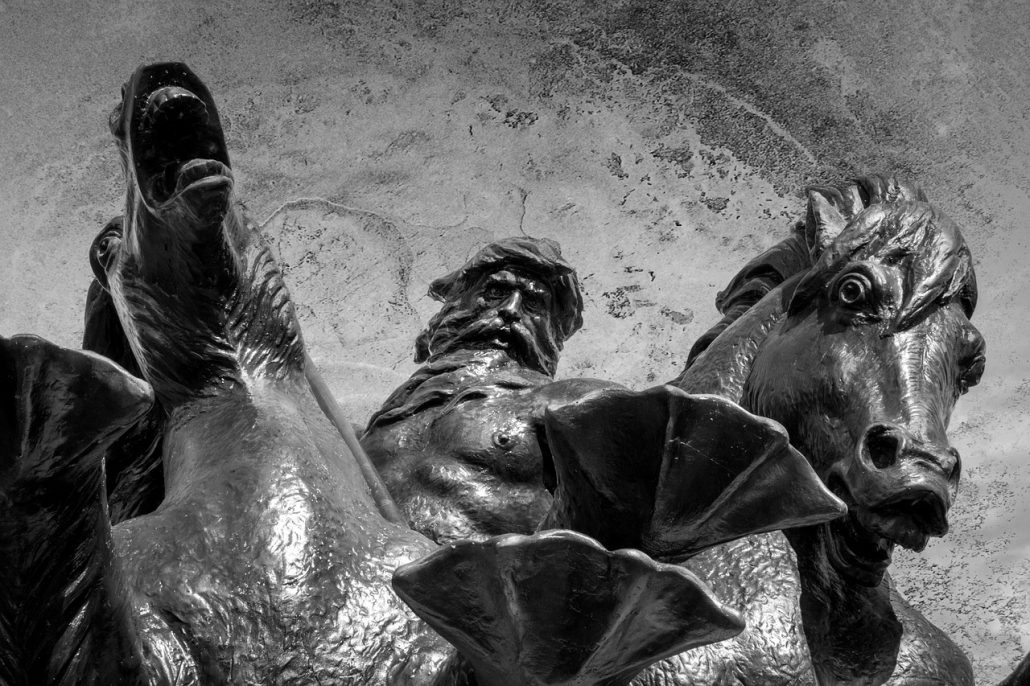Poseidon, in Greek religion and mythology violent and ill-tempered god of the sea, earthquakes, and horses. One of the Twelve Olympians he is distinguished from Pontus, the personification of the sea and the oldest Greek divinity of the waters. Poseidon had many disputes with both gods and men, most famously with Athena and Odysseus. Poseidon’s name is very old, and its meaning is lost but various authors have tried to translate it as either“ means either “husband of the earth” or “lord of the earth.”
Family
Poseidon was the second son of Cronus (the youngest of the 12 Titans) and Rhea (after Hades) and their penultimate child (before Zeus). Hestia, Demeter, and Hera were his sisters. When the Universe was divided among the gods, the seas were taken by Poseidon who is called Neptunus in Latin. Thus he became the sole ruler of the seas, coasts and islands. Poseidon means the ruler of the sea. It is often cited in legends as the earth-shaking god. Poseidon is the son of Cronus and Rhea and brother of Zeus.
Disputes with Zeus
Poseidon had a very violent character, Impulsive and hot-blooded, he couldn’t put up with Zeus’ arrogant behavior as a ruler. He had an undying resentment against Zeus, whom he sometimes challenged but had to give in each time in the face of Zeus’s power. He shook the earth with the help of his trident fishing spear, frothed the sea but would remain weak compared to the thunderbolts of Zeus. According to the Greek poet Hesiod, Poseidon’s trident, like Zeus’s thunderbolt and Hades’ helmet, was fashioned by the three Cyclopes.
Poseidon and Athena
Poseidon was also a greedy god and he wanted to obtain Athens from Athena, claiming that the city would have much more benefit from him than her. To prove this, he struck his trident into a rock, creating a seawater stream which welled up in the Temple of Erechtheion on the north side of the Acropolis. Athena, in turn, planted an olive tree. Cecrops, the first king of Athens, decided that Athena’s gift was more useful since it gave fruit, wood, and oil. Athena kept Athens, and ever since then, the olive branch is a universal symbol of peace.
Poseidon’s Women and Children
Poseidon married Amphitrite, who was one of the fifty daughters born from the union of Doris (Oceanus’s daughter) and Nereus. They lived in their golden palace on the sea between Tenedos and Imbros (respectively Bozcaada and Gökçeada in Turkish). There were many water deities at the disposal of Poseidon. Daughters of Nereus were among these. Leading among them were Achilles’s mother Thetis and Amphitrite. Poseidon’s marriage to Amphitrite produced Tritonwho would raise or calm the waves. He too was at the disposal of Poseidon. Following them in rank were the nymphs, who were decipted as nubile maidens and represented the uplifting power of water. Apart from these, poseidon also begat notorious giant sons from other women. His marriage to Gaia brought forth Antaeus. Heracles defeated this giant and secured the roads. Form the union of Poseidon with a nymph named Thoosa came forth Polyphemus whı was a Cyclopes. Poseidon himself fathered many horses, best known of which was the winged horse Pegasus by the Gorgon Medusa.
Poseidon and Odysseus
When Polyphemus ate Odysseus’s men in a cave, Odyseeus blinded him by sticking a hot olive branch into his eye. Poseidon exacted revenge on Odysseus for his son by driving him from one sea to anothers for years. Poseidon’s union with Aetra, daughter of King Pittheus of Troezen, brough forth Theseus. Poseidon would unleash sea monsters upon those whom he wanted to punish. This is how he punished King Laomedon of Troy who failed to pay Poseidon and Apollo their wages for building the walls of Troy as Zeus cendemned them to do. A Trojan priest who declared taht the Trojan horse was a trick,Laocoon was suffocated together with his sons by the snakes of Poseidon.
In Art
This scene of suffocation became a source of inspiration for sculptors, generating a visually appealing sculpture art. Poseidon admired Demeter. He wanted to seduce her but rejected by her. Demeter disguised herselfdisguised herself as a horse to escape him but Poseidon disguised himself as a horse and ravished her. It is also told that he made love to the gorgon Medusa on the grass. Poseidon rode on his chariot pulled by for purebred horses with golden mane. The waves would calm down where his chariot passed and sea animals would swim by his chariot. When he was mad, boisterous waves would hit the coasts, spreading their white foams around. He did not only rule the seas, he could shatter the coasts if he saw fit.
Poseidon at museums
There are various magnificent marble and bronze scupltures of Poseidon at museums. The bronze Poseidon sculpture at Louvre is very impressive and dates to the 2nd century BC. The bronze sculpture of Poseidon at the National Museum of Athens, dating to 460 BC, is also marvellous. There are replicas of this bronze sculpture in other museums. The Madrid, Louvre and Vatican museumsare also home to sculptures of Poseidon. A marble sculpture of Poseidon found on the island of Melos, which dates to 130 BC, is also at the National Museum island of Athens. In addition to the temples devoted to Poseidon in Greece, which date to 5th century BC, the one devoted to Neptune in Italy are also very enchanting. Not many temples can be spoken of his name in Anatolia since he did not have much activity there.
Turkish museums have many sculptures of Poseidon as well, in which he quite resembles Zeus. A remarkable example is a statue of Poseidon together with Demeter from the 2nd century BC, which was found at the agora of İzmir and is exhibited in the Museum of İzmir today.
He is decipted as broad shouldered and with his long curly hair flowing down on his shoulders, either naked or with clothes, but always with his tridenty fishing spear in his hand. He is sometimes illustrated as stepping on a rock or the back of a dolphin. Tuna fish, dolphins, horses and bulls were animals that were dedicated to him. His wife Amphitrite is decipted with her wet hair gathered to in a net, accompanied by dolphins, tritons and oysters. Poseidon is also known as Neptune in Latin. He is also seen on the altar reliefs of Pergamum while fighting against the Giants on his chariot drawn by four horses on the mosaics.
The cult of Poseidon was acclaimed in places such as Delphi, Thessaly, Athens, Corinth and Delos. There is a 5th century BC Doric tempel dedicated to him on Cape Sounion located to the South of Athens in Greece on a mountainous area overlooking the sea, which is looked up to admiringly by the passing ships.
Paestum was one of the most beautiful and developed cities established by the Hellenic tribes in southern Italy, which is known as Magna Graecia today. Many tempels in theis area survived intact to this date. The Temple of Poseidon from the 5th century BC, is also remarkable with its spectacular Outlook.

